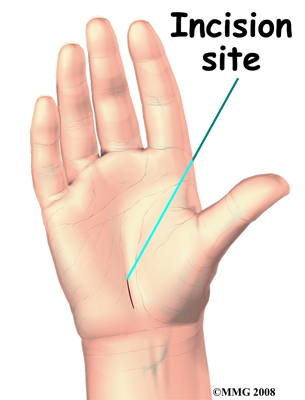Carpal Tunnel Decompression - Orthopaedic Surgery
Surgical treatment of carpal tunnel syndrome involves cutting the transverse carpal ligament to release compression of the median nerve. The procedure is done under local anaesthetic and takes around 10-20 minutes. Most patients will be able to go home on the day of their operation. Most patients are helped by these procedures and will be able to return to their jobs and daily activities successfully with no long-term problems.
To begin, the patient lies flat on an operating table with their hand on a hand table with the hand and forearm numbed by local anaesthetic. The surgeon will test if pain can be felt; if so then more anaesthetic is given, or if not, then the procedure can begin. If the patient is overly anxious they can request a sedative to help keep calm.
To help visualise the procedure, an initial 1-2 inch incision is made, the location of which depends on the type of surgery the surgeon has chosen. In open surgery, the surgeon separates the skin and works through an "open" incision to cut the transverse carpal ligament. In endoscopic surgery, the surgeon makes an incision to insert an endoscope, a small camera, into the incision and then cuts the ligament. These are shown below.


Following the initial incision, subcutaneous fat and palmar tissue, fat below the skin and sometimes some palm muscle, is dissected to expose the transverse carpal ligament, the band of tissue responsible for the compression and pain. The ligament is then separated from the nerves and blood vessels underneath it and cut to release the median nerve. Once the nerve has been checked to make sure there is no more compression, the incision is closed and stitched up.
Once the procedure has been completed, the hand and forearm will still be numb and care should be taken to avoid using or hitting anything with it. The doctor will prescribe pain medication following the operation and the patient will usually be allowed to go home if there are no complications. The patient will be scheduled for a follow-up 2 weeks after the operation in an outpatient setting and then again at 3 months after to assess progress. Recovery is usually 6-12 weeks for full return to previous activities. Usually, the surgeon will be able to provide their own estimate upon request.
Comments